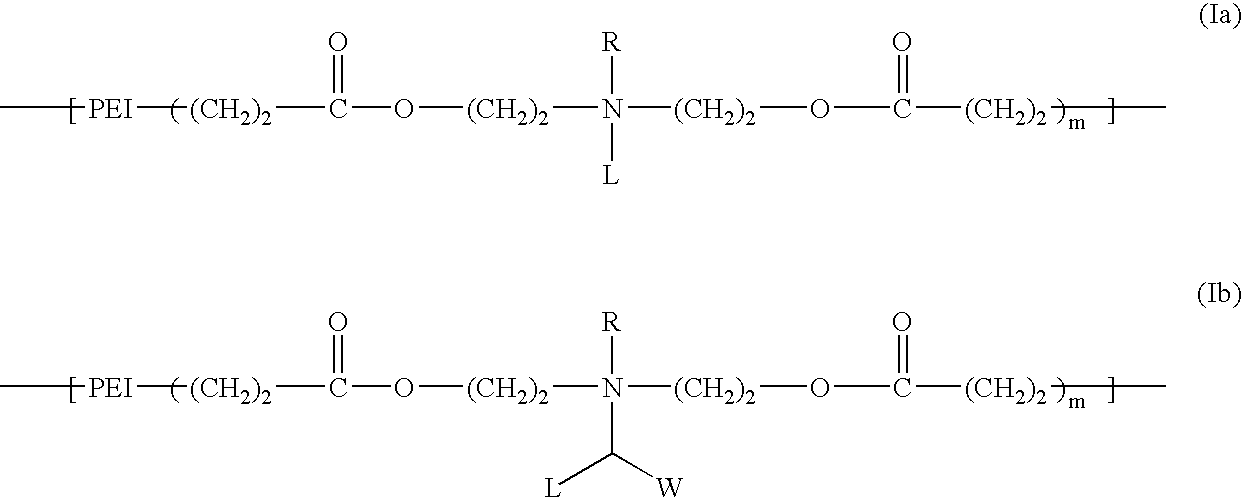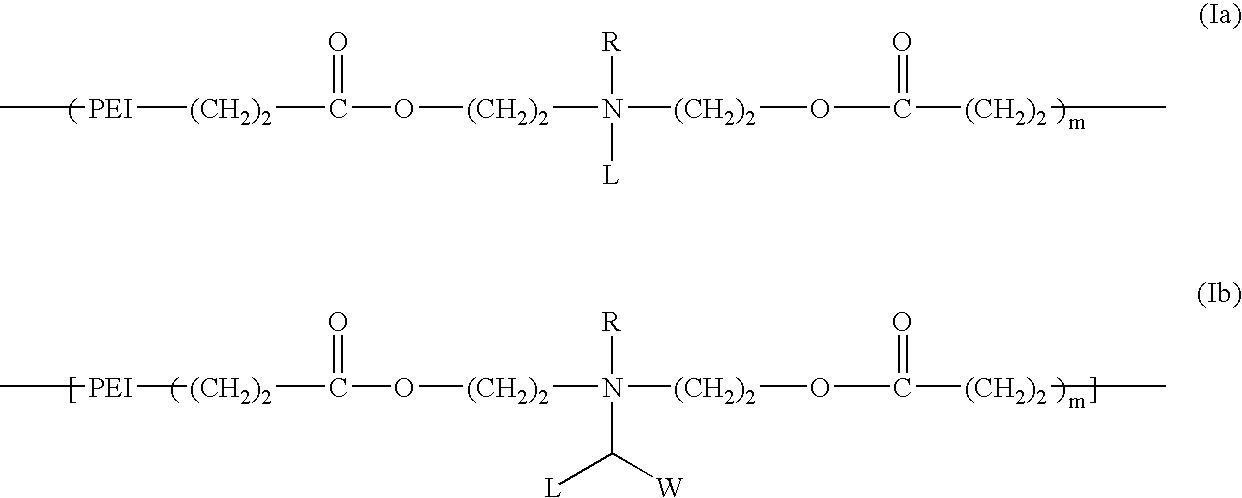Biodegradable cationic polymers
a cationic polymer and biodegradable technology, applied in the field of cationic lipopolymers, can solve the problems of high molecular weight pll, high cost, complex and expensive process of virus vector preparation, etc., and achieve the effect of increasing the degradation rate of polymer and facilitating the delivery of biomolecules
- Summary
- Abstract
- Description
- Claims
- Application Information
AI Technical Summary
Benefits of technology
Problems solved by technology
Method used
Image
Examples
example 1
[0054]
[0055] Oxalyl chloride (13.5 mL, 152 mmol) was added to a solution of oleic acid 1 (10.7 g, 38 mmol) in dichloromethane (DCM, 200 mL) and N,N-dimethylformamide (DMF, three drops) at 0° C. The reaction mixture was stirred for about 1 hour and then allowed to warm to room temperature. After 1 hour, the solution was diluted with toluene and distilled. The residue was dissolved in dichloromethane (200 mL) and cooled to 0° C. Diethanolamine (10.9 mL, 114 mmol), 4-(dimethylamino)pyridine (490 mg, 4 mmol), and triethylamine (21 mL, 152 mmol) were added to the solution. The solution was stirred at 0° C. for 30 minutes and then allowed to proceed at room temperature overnight. The reaction mixture was diluted with dichloromethane and washed with 1 N HCl and aqueous NaHCO3. The organic phase was dried (Na2SO4) and concentrated under reduced pressure. The crude residue was then purified on a silica gel column (10:1 ethyl acetate:methanol), yielding 13.5 g (99.9%) of compound 2 as a color...
example 2
[0056]
[0057] Triethylamine (8.1 g, 80 mmol), DMAP (0.5 g, 4 mmol) and 2 (7.1 g, 20 mmol) was dissolved in 200 ml of dichloromethane at room temperature. The system was flushed with argon and the solution was cooled in an ice bath. Acryolyl chloride (5.4 g, 60 mmol) in 25 ml of dichloromethane was added dropwise. After the addition the reaction was allowed to warm to room temperature and stir overnight. The reaction mixture was diluted with dichloromethane and washed with water and aqueous NaHCO3. The organic phase was dried (Na2SO4) and concentrated under reduced pressure. The crude residue was then purified on a silica gel column (1:3 ethyl acetate:hexane), yielding 7.5 g (81%) of compound 3 as a colorless oil.
example 3
[0058] The synthesis of a cationic lipopolymer was carried out in accordance with Scheme A by reacting polyethylenimine having a molecular weight of 600 (PEI-600) with compound 3 as follows: About 0.6 g of PEI-600 (Aldrich) was weighed and placed in a small vial, and 10 ml of ethanol was added. After the PEI-600 completely dissolved, 3.7 g (8.0 mmol) of 3 in 10 ml of ethanol was added quickly into the PEI solution while stirring. The reaction mixture was stirred for 2 hours at room temperature. After removing the organic solvent under reduced pressure, a transparent, viscous liquid was obtained. 1H-NMR spectrum indicated that the acrylic carbon-carbon double bond disappeared completely. The molecular weight of the obtained polymer was estimated by agarose gel electrophoresis. This is a general procedure that serves as a model for other synthetic procedures involving similar compounds, and may be used to synthesize a series of degradable cationic lipopolymers.
PUM
| Property | Measurement | Unit |
|---|---|---|
| molecular weight | aaaaa | aaaaa |
| Molecular weights | aaaaa | aaaaa |
| Molecular weights | aaaaa | aaaaa |
Abstract
Description
Claims
Application Information
 Login to View More
Login to View More - R&D
- Intellectual Property
- Life Sciences
- Materials
- Tech Scout
- Unparalleled Data Quality
- Higher Quality Content
- 60% Fewer Hallucinations
Browse by: Latest US Patents, China's latest patents, Technical Efficacy Thesaurus, Application Domain, Technology Topic, Popular Technical Reports.
© 2025 PatSnap. All rights reserved.Legal|Privacy policy|Modern Slavery Act Transparency Statement|Sitemap|About US| Contact US: help@patsnap.com



